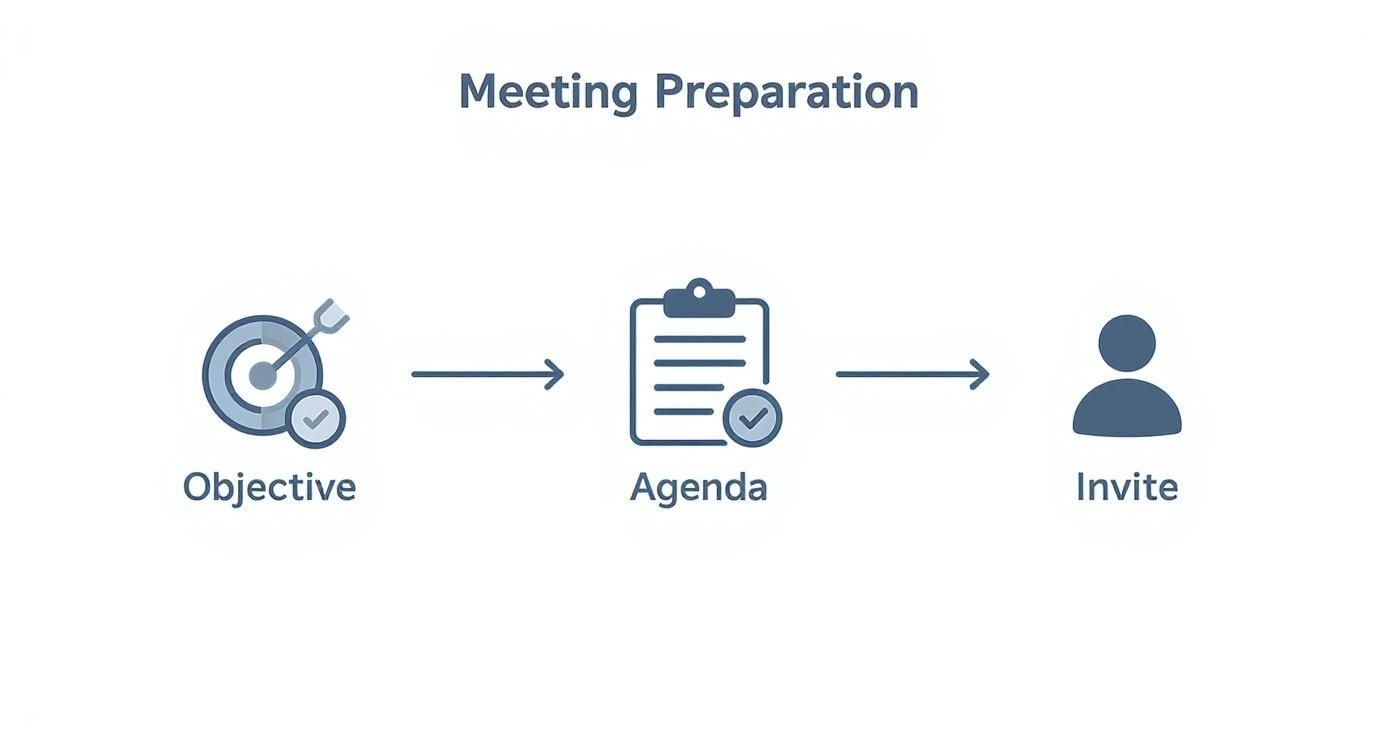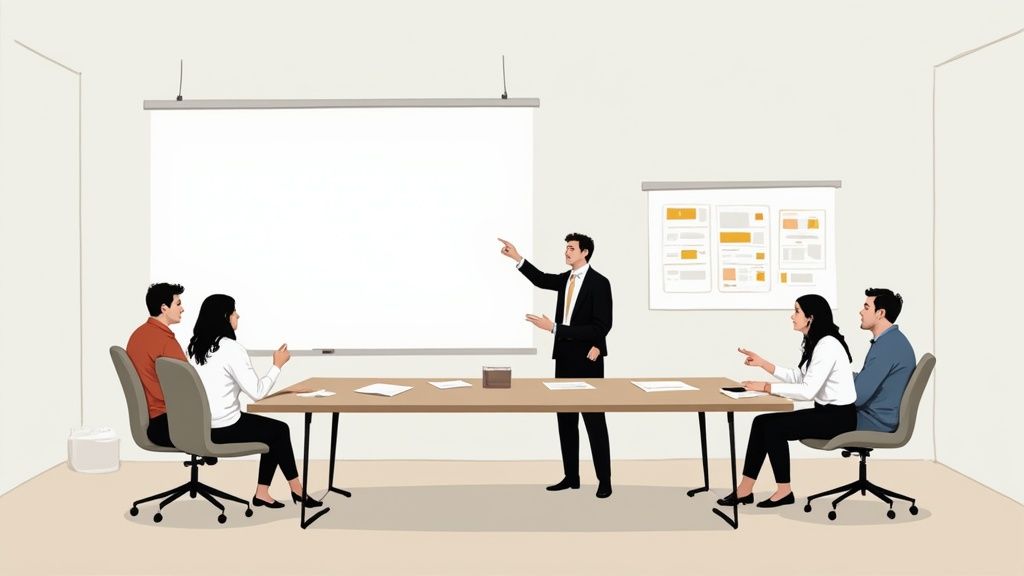How to Conduct Effective Meetings That Drive Results

Let's be honest, the phrase "I have a meeting" rarely sparks joy. More often than not, it triggers a sense of dread. This isn't just a feeling; it's a symptom of a massive drain on company resources, morale, and productivity.
So many of us find our calendars jammed with back-to-back discussions that just circle a topic without ever landing on a conclusion. We're left with less time for the deep, focused work that actually moves the needle.
Why Most Meetings Are Broken
The root of the problem is a fundamental lack of intentionality. Too often, meetings are scheduled out of habit, not necessity. They get slapped on the calendar without a clear, singular objective.
This leads to bloated invitation lists, rambling conversations that go nowhere, and that all-too-familiar feeling that everyone's time has just been wasted. We're not having work sessions; we're just having updates that could have been an email.
The Staggering Cost of Ineffective Meetings
The financial and cultural fallout from this is enormous. Ineffective meetings are estimated to cost the US economy a staggering $37 billion annually. That number isn't just about lost hours; it's about a work culture that's struggling to get things done.
Think about this: between 36 and 56 million meetings happen every day in the US, yet nearly two-thirds (65%) of professionals feel they’re a waste of time. You can see the full breakdown of these meeting statistics and their impact on myhours.com.
This data makes one thing crystal clear: learning how to run a good meeting is a critical business skill, not a soft one. It’s about reclaiming precious time and energy. Of course, knowing why meetings fail is only half the battle. If you want a deep dive into fixing them, check out this a comprehensive guide to running effective team meetings.
Shifting Your Approach with the Right Tools
The good news? You can absolutely fix your meeting culture. It starts with a simple but powerful shift in mindset: treat every single meeting like a valuable, limited resource. This means every gathering must have a purpose that simply can't be achieved asynchronously through an email or a message.
The goal is to transform meetings from time sinks into powerful drivers of progress. This is where preparation and the right tools become your greatest assets.
You can supercharge this shift with tools designed for better preparation and knowledge sharing. Take Obsibrain, for example. It allows you to create a central hub for all pre-meeting materials right within your Obsidian vault. For instance, when planning a quarterly review, you can create a meeting note in Obsibrain and link it to the past quarter's performance dashboards, sales reports, and the previous review's action items. This ensures every participant shows up with the context they need, ready to contribute meaningfully from the very first minute, not spending twenty minutes just getting up to speed.
Planning Your Meeting for Success Before It Starts
A productive meeting is won or lost long before anyone clicks the ‘Join’ button. I’ve seen it time and time again: the most common pitfall is treating preparation as an afterthought. This pre-meeting phase is where you lay the foundation for focus, engagement, and clear outcomes. Without a solid plan, you're just setting the stage for wasted time.
The first, non-negotiable step is to define a single, razor-sharp objective. Don’t just schedule a “Project Update.” Instead, frame the goal as a decision or a tangible output. Think: “Decide on the Q3 marketing budget allocation” or “Finalize the user feedback implementation plan.”
This focus on a singular purpose naturally shapes the entire rest of your planning process.

This simple flow really highlights how a clear objective directly informs who needs to attend and what the agenda must cover. By following this sequence, you naturally avoid bloated invite lists and unfocused discussions, making sure every part of the meeting serves its core purpose.
Build a Results-Oriented Agenda
With your objective locked in, it's time to build an agenda that works as a roadmap to that goal, not just a list of topics. The numbers here are pretty shocking: a startling 64% of recurring meetings and 60% of one-off meetings don't even have a structured agenda.
This is a huge reason why US employees spend an average of 392 hours—that's nearly 49 full workdays—in meetings each year. If you're curious, you can dive into more data on meeting culture in this in-depth statistical report.
To avoid this trap, structure your agenda with questions to be answered or decisions to be made. Shifting from a topic to an outcome changes everything.
I see vague agenda items all the time. Here's how to reframe them to be radically more effective:
Traditional Agenda vs Results-Oriented Agenda
"Discuss Website Redesign"
"Review and approve final wireframes for the homepage"
"Marketing Update"
"Decide which of the 3 proposed campaigns to launch in Q4"
"Budget Review"
"Finalize the Q2 software spending and identify areas for reduction"
"Talk about sales performance"
"Analyze last month's sales data and agree on 2 new lead-gen tactics"
See the difference? One is a passive discussion; the other is a call to action. An outcome-focused agenda puts everyone in the mindset of getting things done from the moment they read the invite.
Strategically Select Your Participants
Your attendee list should be lean and purposeful. For every single person you consider inviting, ask yourself two critical questions:
Is their input absolutely essential to achieve the meeting's objective?
Are they directly impacted by the decisions that will be made?
If the answer to both is "no," they probably don't need to be there. A small group of relevant stakeholders is always more effective than a large audience of passive listeners. For those who just need to be kept in the loop, a crisp summary after the meeting is a much better use of their time.
A meeting is not a performance. It's a working session. Only invite the people who are there to do the work.
Distribute Pre-Meeting Materials with Obsibrain
This is where you can truly set your team up for success. Circulating a dynamic agenda ahead of time transforms a meeting from a lecture into a real collaborative session. Using a tool like Obsibrain is perfect for this.
Inside your Obsidian vault, you can create a single meeting note that contains the agenda and directly links to all the necessary background documents—previous meeting notes, relevant data, project briefs, you name it. A great use case is for client kick-off meetings. You can create a note in Obsibrain for the meeting and link it to the client's profile, the signed contract, and the initial project scope document. This creates a single source of truth that everyone can review beforehand. To learn more about how this works, check out the documentation on Obsibrain's dedicated meeting and CRM features.
When everyone shows up with the same context, you can skip the long-winded background summaries and dive straight into productive discussion. This one practice is one of the most powerful ways to run meetings that actually respect everyone’s time.
Facilitating Engaging and Productive Discussions
Once you've done the prep work, the real action begins in the meeting itself. This is where solid facilitation skills can turn a standard get-together into a genuine productivity engine. A good facilitator is a guide—steering the conversation, making sure everyone gets a chance to speak, and keeping a close eye on the clock.
The first 60 seconds of any meeting are crucial; they set the tone for everything that follows. Before jumping into the agenda, take a moment to ground the room. Kick things off by clearly restating the meeting's single, non-negotiable objective. This simple act reminds everyone why they're there and builds a shared sense of purpose from the get-go.

This initial framing gives you, the facilitator, an anchor to bring the conversation back to if things start to drift.
Keeping the Conversation Focused and Inclusive
Even the best-planned agendas can't prevent conversations from wandering off course. This is where a classic facilitator's tool, the "parking lot," comes in handy. When a great but off-topic idea pops up, don't dismiss it. Instead, acknowledge its value and jot it down in the parking lot—a dedicated spot on a whiteboard or in a shared note—to circle back to later.
This technique validates the person's contribution without derailing the meeting's momentum. It's about respecting ideas while maintaining control. Another key part of facilitation is managing the different personalities in the room.
For the Dominant Talker: Politely jump in with something like, "That's a great point, thank you. To make sure we get a range of perspectives, I'd love to hear what others are thinking."
For the Quiet Contributor: Create an opening for them. A direct but gentle question works well: "Maria, you've got a lot of experience here—what are your thoughts on this?"
If you really want to boost engagement and keep the energy up, try weaving in a few top interactive workshop activities. They can transform a passive meeting into a dynamic, collaborative session.
Using Obsibrain as a Real-Time Collaboration Hub
This is where technology can seriously level up your facilitation game. Instead of one person furiously typing notes in isolation, use Obsibrain as a shared, real-time collaboration space. Assign one person to be the notetaker, capturing key points, decisions, and action items directly into a shared note that everyone can see.
A practical use case is a weekly team sync. As each person gives their update, the notetaker can add bullet points under their name in the shared Obsibrain note. If a decision is made or a blocker is identified, it can be immediately tagged and linked to the relevant project file. This approach is incredibly powerful for building instant alignment because everyone sees what's being recorded and can flag misunderstandings right away. No more "Wait, who agreed to what?" confusion after the meeting—the consensus is built and documented as it happens.
Live, shared note-taking eliminates ambiguity and creates a single source of truth for the meeting's outcomes as they happen.
This process also connects seamlessly with Obsibrain's other features. As decisions are made, the notetaker can log them with a simple command. Action items can be quickly assigned to team members, all ready to be converted into trackable tasks. With Obsibrain's features for quick capture and note creation, no important detail gets lost in the flow of conversation. It effectively turns a simple discussion into a documented, actionable work session.
Ensuring Action and Follow-Through After the Meeting
Let's be honest: a meeting that ends without a clear plan for what comes next is little more than a conversation. All that talk? It’s just talk. The real value gets unlocked by the actions that follow. This is where momentum is either built or completely lost, and it’s a critical part of mastering how to conduct truly effective meetings.
The single most important post-meeting task is sending out a concise summary within 24 hours. This isn't a transcript of the entire conversation. It's about boiling the discussion down to its most vital parts: the key decisions made and, most importantly, the action items that will actually drive progress.
Crafting an Effective Meeting Summary
A great summary provides clarity and creates accountability. It becomes the official record of what was agreed upon, heading off any future confusion or "I thought we decided..." moments. Think of it as the roadmap for the work that follows.
Your summary should always have three core elements:
Key Decisions: A bulleted list of the major conclusions reached. Be specific here. Don't just say "Discussed marketing." Instead, write "Approved the Q4 social media campaign budget of $15,000."
Action Items: This is the most crucial part. Every single item needs a clear task, an assigned owner, and a firm deadline. This leaves zero room for ambiguity.
Next Steps: Briefly mention the date of the next check-in or any other upcoming milestones related to the discussion.
A great meeting summary doesn't just recap what was said; it clarifies what will be done. It transforms discussion into documented, actionable tasks.
Turning Notes into Action with Obsibrain
This whole follow-up process can be incredibly efficient when you have the right tools in your corner. This is a perfect example of where Obsibrain really shines.
Instead of starting from scratch after the meeting, you can use the notes and decisions you captured in a shared Obsidian note during the discussion. With just a few clicks, you can convert those raw, shared notes directly into a structured, clean summary.
A common use case involves project planning meetings. During the session, you identify five key tasks for the next sprint. Using Obsibrain, you can highlight these lines in your meeting notes and instantly convert them into trackable tasks, assign them to team members, and set due dates. These tasks can then be linked back to the original meeting note and the project's central knowledge base. For a deeper dive into how this works, you can explore more about Obsibrain's action-oriented features.
This creates a clear, auditable trail of accountability that ensures nothing ever falls through the cracks. It connects the conversation to the actual work, keeping your project's momentum going long after everyone has left the meeting room.
Grappling with the Chaos of Modern Meetings
Let's be honest: the way we meet has gotten complicated. We're juggling remote teams, hybrid schedules, and a constant barrage of digital pings. Learning to run a great meeting today means tackling these new hurdles head-on, from the soul-crushing Zoom fatigue to those "quick calls" that completely torpedo your focus. The antidote isn't more meetings; it's being far more intentional about when and why you gather in the first place.

The data backs this up. Almost a third of meetings now span multiple time zones, a figure that's jumped 35% since 2021. What's even more disruptive? A staggering 57% of meetings are ad-hoc, popping up without any calendar invite and derailing planned work. While it's good that 56% of people leave meetings with clear action items, 32% still walk away thinking, "that could have been an email." If you're curious, you can dig into more of these meeting statistics here.
To Meet or Not to Meet? That Is the Question.
The most powerful move you can make is to draw a hard line between synchronous (live) and asynchronous (on your own time) communication. Not every update needs a live audience. In fact, most don't. This is where you reclaim your team's time.
Save those precious real-time meeting slots for the stuff that actually benefits from live interaction:
Brainstorming Sessions: The creative energy of a group bouncing ideas off each other in real-time is hard to replicate asynchronously.
Complex Problem-Solving: When you're untangling a tricky issue, the rapid back-and-forth of a live conversation is essential.
High-Stakes Decisions: For critical choices that need debate and immediate alignment, a meeting is non-negotiable.
Building Team Culture: Sometimes, the whole point is just to connect on a human level. Don't underestimate the value of that.
For everything else—status updates, sharing information, routine check-ins—an async-first approach is far more respectful of everyone's focus.
Forging a Healthier Meeting Culture with Obsibrain
Changing habits is hard, but the right tools can make it much easier. One of the simplest yet most effective strategies is to establish a ‘no-meeting day’—pick a Wednesday or Friday and block it off for uninterrupted deep work. This single rule can do wonders for productivity and morale.
This is where a tool like Obsibrain slots in perfectly. Instead of defaulting to a meeting for project updates, you can use a shared project note inside your Obsidian vault. For instance, a marketing team can maintain a "Q3 Campaign Launch" note where each team member adds their weekly progress on ad creatives, copy, and analytics. The project lead can review this at their convenience and leave comments, eliminating the need for a 30-minute status call.
The goal is to make asynchronous communication the default for sharing information, saving your synchronous time for true collaboration.
With Obsibrain, you centralize all these rolling updates into a single, living document. Everyone stays in the loop without being pulled from their tasks. It's a natural fit for teams spread across different time zones, as people can contribute whenever their workday starts. By using it for updates, you automatically start reserving your meetings for the high-value conversations that truly require them.
Frequently Asked Questions About Effective Meetings
Even with a solid framework, a few questions always pop up when you're trying to shift your team’s meeting culture. Honestly, getting these details right is what separates meetings that deliver real value from the ones that just drain everyone's energy.
Here are a few common situations you’ll likely run into.
How Long Should a Meeting Ideally Be?
Shorter is almost always better. I tell my teams to aim for 30 minutes as a default. If you have a sharp objective and a tight agenda, that’s usually more than enough time to hash things out and decide on next steps.
For those deeper problem-solving or strategy sessions, you might need 45-60 minutes, but schedule that length intentionally, not automatically. A neat trick is using a tool like Obsibrain for pre-reading. For a technical design review, you could share an Obsibrain note with the proposed architecture diagrams and documentation 24 hours in advance. This dramatically shortens the meeting because you can jump straight into the discussion instead of wasting time bringing everyone up to speed.
What Is the Best Way to Handle Someone Who Dominates the Conversation?
This one takes a bit of finesse. A skilled facilitator can handle this gracefully without making anyone feel called out. The key is to acknowledge their point, then intentionally redirect the conversation.
Try saying something like, "Great point, John. To make sure we hear from everyone, I'd like to ask Sarah for her perspective." This approach is polite but firm, and it reinforces that you expect balanced participation.
Another method I’ve found effective is a simple round-robin, where each person gets an uninterrupted turn to speak. This structure naturally creates space for the quieter voices in the room.
How Can I Reduce the Number of Meetings My Team Has?
Start with a simple meeting audit. Seriously, just go through your calendar and question every single recurring meeting. Is it still essential? Could this update be handled with a quick email or an asynchronous report? You'll be surprised how many you can slash immediately.
From there, promote a culture of asynchronous communication for anything that's just a routine status update. A shared platform like Obsibrain is perfect for this. For example, instead of a daily stand-up meeting, each team member can post their "Today's Focus" and "Blockers" in a central project note in Obsibrain. This reserves that precious live meeting time for what it’s actually good for: collaborative brainstorming, complex problem-solving, and making critical decisions together.
Ready to transform your meetings and centralize your entire workflow? Obsibrain provides the structure you need to plan, execute, and follow up on every task, note, and goal without ever leaving your vault. Start optimizing your productivity today at https://www.obsibrain.com/en.
Last updated
Was this helpful?